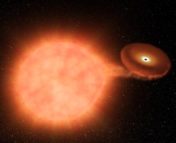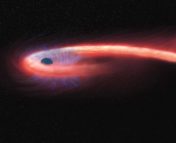Title: The Koala: A Fast Blue Optical Transient with Luminous Radio Emission from a Starburst Dwarf Galaxy at z = 0.27
Authors: Anna Y. Q. Ho, Daniel A. Perley, S. R. Kulkarni, Igor Andreoni, Eric C. Bellm, Kevin B. Burdge, Poonam Chandra, Michael Coughlin, Kishalay De, Richard Dekany, Dillon Z. J. Dong, Michael Feeney, Dmitry D. Frederiks, Christoffer Fremling, V. Zach Golkhou, Matthew J. Graham, David Hale, George Helou, Assaf Horesh, Mansi M. Kasliwal, Russ R. Laher, Frank J. Masci, Adam A. Miller, Michael Porter, Anna Ridnaia, Ben Rusholme, David L. Shupe, Maayane T. Soumagnac, Dmitry S. Svinkin
First author’s institution: Cahill Center for Astrophysics, California Institute of Technology
Journal: Submitted to the Astrophysical Journal. Open access on ArXiv.
Furry Animals and Relativistic Transients
Astrophysicists love clever titles, and in transient astronomy, we can get some fun ones! Transient sky surveys discover thousands of new explosions every year, with each one receiving a name based on when it was discovered. For example, in 2018, a peculiar transient called Astronomical Transient (AT) 2018cow was discovered and aptly deemed “the Cow” after the last letters of its International Astronomical Union (IAU) name. Coincidently, the Cow happened to be so unique that it received worldwide acclaim as one of the most exciting discoveries of 2018!
Following its discovery, the Cow became the prototypical transient in a new class of explosions called Fast Blue Optical Transients (FBOTs), whose name is reflective of their unique observational signatures. After detection, FBOTs rise to peak brightness in only a few days (i.e. fast!) and have extremely hot temperatures, which makes them appear bluer in color than typical supernova explosions. However, astrophysicists are still puzzled at how objects like the Cow are formed: a black hole shreds a white dwarf? Or maybe a massive star implodes to form an accreting black hole or magnetar? Either way, FBOTs present a fresh mystery that can only be solved by finding and studying similar events!
Innocuous Bear or Violent Explosion?
The authors of today’s paper present the discovery of a fuzzy new FBOT, ZTF18abvkwla, which was nicknamed the “Koala” after the last four letters of its official transient name. Furry animals keep making their way into astrophysics! Unlike earth-based koalas, this transient creature is anything but docile: observations spanning the electromagnetic spectrum revealed that the Koala was a luminous event whose turbulent explosion resulted in high temperatures and rapid ejection of stellar material. The Koala was first observed by the Zwicky Transient Factory and is located in a distant dwarf galaxy with a high star formation rate of 7 solar masses per year. The large number of new stars in the Koala’s host galaxy may indicate that this FBOT came from the explosion of a young massive star rather than from an older star system containing a white dwarf.
As shown in Figure 1, the authors demonstrate that the Koala’s luminosity evolution (i.e., light curve) is very similar to the Cow’s: rising to peak brightness in only a few days, very blue colors and a rapid decline in magnitude. Consequently, studying how FBOT light curves evolve in time is a powerful tool in uncovering the origin of these mysterious explosions. For instance, FBOTs rise and fade too quickly (day timescales) to be powered by radioactive decay of heavy elements, which is the mechanism invoked for most supernovae and occurs on about week timescales.
To produce both a luminous and rapidly evolving light curve like the Koala’s, the author’s discuss the possibility that the explosion was powered by the collision of outflowing material with gas in the local environment. However, this gas must also be quite opaque to radiation since the spectrum (Fig. 2) does not show Hydrogen or Helium emission lines that typically occur from an explosion interacting with material surrounding the progenitor star. Contrary to the comfortable climates of Australia’s native bear, the Koala’s spectrum revealed that it was an incredibly hot explosion that reached temperatures > 40,000 Kelvin!
The final piece of the puzzle discussed in today’s paper is the detection of luminous radio emission coming from the Koala. Shown in Figure 3, the Koala has one of the highest radio luminosities of any FBOT-like event (black stars), which is an important clue in deciphering the mechanisms behind the explosion. Similar to the Cow, the authors conclude that the observed radio emission arose from an outflow of material moving at almost half the speed of light. That’s 100 million times faster than a koala running on Earth! This turbulent ejection of material in the Koala may be linked to the formation of a central engine like a black hole or rapidly rotating neutron star. Such a compact object could accrete material from an exploded star and violently expel semi-relativistic gas that would be visible as radio emission.
While not your average woodland critter, the Koala has exposed how little we know about where FBOTs come from and the physics behind their energetic explosions. Unfortunately, understanding their complex origins will be difficult, as the authors conclude that the revised rate of FBOT discovery is almost 3 orders of magnitude less than that of typical supernovae. Nonetheless, new advancements in sky surveys will increase the number of new FBOTs and, with any luck, they will have more animal-themed names!




